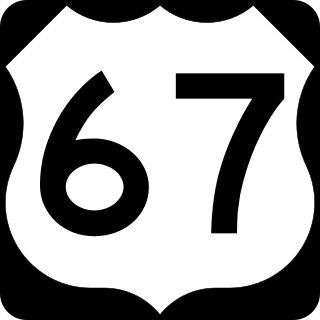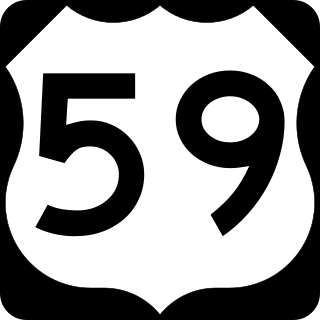
U.S. Route 67 is a major north–south U.S. highway which extends for 1,560 miles (2,511 km) in the Central United States. The southern terminus of the route is at the United States-Mexico border in Presidio, Texas, where it continues south as Mexican Federal Highway 16 upon crossing the Rio Grande. The northern terminus is at U.S. Route 52 in Sabula, Iowa. US 67 crosses the Mississippi River twice along its routing. The first crossing is at West Alton, Missouri, where US 67 uses the Clark Bridge to reach Alton, Illinois. About 240 miles (390 km) to the north, US 67 crosses the river again at the Rock Island Centennial Bridge between Rock Island, Illinois, and Davenport, Iowa. Additionally, the route crosses the Missouri River via the Lewis Bridge a few miles southwest of the Clark Bridge.

U.S. Route 160 (US 160) is a 1,465-mile-long (2,358 km) east–west United States Numbered Highway in the Midwestern and Western United States. The western terminus of the route is at US 89 five miles (8.0 km) west of Tuba City, Arizona. The eastern terminus is at US 67 and Missouri 158 southwest of Poplar Bluff, Missouri. Its route, if not its number, was made famous in song in 1975, as the road from Wolf Creek Pass to Pagosa Springs, Colorado in C.W. McCall's country music song "Wolf Creek Pass".

U.S. Highway 18 (US 18) is an east–west United States Numbered Highway in the Midwestern United States. The western terminus is in Orin, Wyoming, at an interchange with Interstate 25 (I-25). Its eastern terminus is in Downtown Milwaukee, Wisconsin. US 18, however, runs concurrent with other U.S. Highways from its western terminus to Mule Creek Junction, Wyoming. US 18 is one of the original U.S. Highways of 1926. The US 18 designation was originally proposed for a road in Michigan from Grand Haven east to Detroit. This roadway was eventually designated as US 16.

Interstate 129 (I-129) is an auxiliary Interstate Highway which connects South Sioux City, Nebraska, to I-29 in Sioux City, Iowa. Opened in 1976, I-129 is a 3.5-mile-long (5.6 km) route, running 3.21 miles (5.17 km) in Nebraska. At 0.286 miles (0.460 km), I-129 is the shortest highway in the state of Iowa. All of the route's length is concurrent with U.S. Route 20 (US 20) and most of its length is concurrent with US 75.

Iowa Highway 9 is the most northern of Iowa's east–west highways, traversing the entire northern tier of counties. It runs from the eastern terminus of South Dakota Highway 42 at the South Dakota border east of Sioux Falls, South Dakota near Benclare, to the Wisconsin border at Lansing where it continues as Wisconsin Highway 82. It is largely rural in character, bypassing any large city. Making a few dips north and south, the highway largely follows a very straight east–west alignment.

Iowa Highway 5 is a highway in southern Iowa. It is a north–south highway with a length of 105 miles (169 km). It is the northernmost segment of a three-state "Highway 5" also involving Missouri Route 5 and Arkansas Highway 5. Portions of the highway are freeway and expressway. It had previously been designated Iowa Highway 60. The southern terminus of Iowa Highway 5 is at the Missouri border southwest of Cincinnati. Its northern terminus is at Interstate 35 at West Des Moines.

Iowa Highway 3 (Iowa 3) is a state highway that runs from east to west across the state of Iowa. It is the longest state highway in Iowa, at 323 miles (520 km) long. Iowa 3 begins at the South Dakota state line where it continues as South Dakota Highway 50 and ends at the Northwest Arterial at the Dubuque city limits. It is designated the American Veterans Memorial Highway for its entirety. It is located approximately halfway between Interstate 80 and Interstate 90.

Iowa Highway 2 is a 251-mile-long (404 km) state highway which runs across the southernmost tier of counties in the U.S. state of Iowa. At no point along its route is Iowa 2 more than 15 miles (24 km) from the Missouri state line, except for a small section near its eastern terminus. Iowa 2 stretches across the entire state; from the Missouri River near Nebraska City, Nebraska, to U.S. Highway 61 (US 61) at Fort Madison. Prior to becoming a primary highway, the route was known as the Waubonsie Trail.

Iowa Highway 4 is a state highway which runs from north to south across the state of Iowa. It is 146 miles (235 km) long, beginning at an intersection with Iowa Highway 44 in Panora and ending at the Minnesota state line north of Estherville. It continues north as Minnesota State Highway 4. The route was created on January 1, 1969, when several route designations were changed to match other states' route numbers. Before 1969, Iowa 4 was known as Iowa 17.

Iowa Highway 12 (Iowa 12) is a 46.212-mile-long (74.371 km) state highway that runs from north to south in northwestern Iowa. The highway begins in eastern Sioux City at U.S. Highway 20 (US 20) and US 75. For the first seven and a half miles (12.1 km) of the route, Iowa 12 is an unsigned highway. The first five miles (8.0 km) are signed only as U.S. Highway 20 Business; the other two and a half miles (4.0 km) are overlapped by Interstate 29 (I-29). From here, the highway lies just east of the Big Sioux River, which separates Iowa from South Dakota. The northern end of Iowa 12 is in Hawarden at an intersection with Iowa 10.

Iowa Highway 92 (Iowa 92) is a state highway that runs from east to west across the state of Iowa. Iowa 92 is 279 miles (449 km) long and is part of a continuous 886-mile (1,426 km) four-state "Highway 92" which begins in Torrington, Wyoming, goes through Nebraska and Iowa and ends in La Moille, Illinois. It begins at the Missouri River in Council Bluffs, where it is a continuation of Nebraska Highway 92. It stretches across the state and serves to roughly demarcate the southern one-third of Iowa. It ends at the Mississippi River in Muscatine where it continues into Illinois as Illinois Route 92. Iowa 92 was designated in 1939 replacing the entirety of the original Iowa 2.

U.S. Highway 20 (US 20) in Iowa is a major east–west artery which runs across the state, separating the northern third of Iowa from the southern two-thirds. It enters Iowa from Nebraska, concurrent with Interstate 129 (I-129) and US 75, crossing the Missouri River at Sioux City. US 20 runs in a more-or-less straight line across Iowa, paralleling 42° 27' N. It leaves Iowa in Dubuque by crossing the Mississippi River into Illinois. Since October 2018, US 20 is a four-lane divided highway for its entire length in Iowa.

Iowa Highway 141 (Iowa 141) is an east–west highway in the western and central portions of the state. It is the most direct link between Sioux City and Des Moines. It also serves as an expressway link between Des Moines and the outlying communities of Perry, Granger, and Grimes. Iowa 141 begins near Sloan at an interchange with Interstate 29 (I-29) at ends at another interchange with I-35 /I-80 on the edge of the Des Moines suburbs of Urbandale and Grimes.

Iowa Highway 44 (Iowa 44) is an east–west highway in the central and west-central portions of the state. It runs parallel to Interstate 80, which runs 10 miles (16 km) to the south for most of Iowa 44's route. Iowa 44 begins at its junction with U.S. Highway 30 four miles (6 km) northeast of Logan. It ends at an interchange with the Iowa Highway 141 freeway at Grimes. Iowa 44 was created in 1969 when Iowa Highway 64 was shortened to its current route in eastern Iowa. Most of the route is a part of the Western Skies Scenic Byway.

Iowa Highway 60 is a north–south state highway in northwest Iowa. The highway runs at a southwest-to-northeast angle. The southern end of Iowa Highway 60 is near Le Mars at a freeway interchange with U.S. Highway 75 and U.S. Highway 75 Business. Its northern end is at the Minnesota border just south of Bigelow, Minnesota, where the highway continues in Minnesota as Minnesota State Highway 60.

Interstate 29 (I-29) is a north–south Interstate Highway in the midwestern United States. In the state of South Dakota, I-29 traverses on the eastern side of the state from the Iowa border near Sioux City to the North Dakota border near New Effington. On its route, I-29 passes through western portions of Sioux Falls, the state's largest city. It travels 252.5 miles (406.4 km) in the state, the longest stretch of any of the four states through which it passes. I-229, the highway's lone auxiliary route in South Dakota, serves as a bypass around southern and eastern Sioux Falls.

U.S. Highway 18 (US 18) is the northernmost east–west United States Numbered Highway in the state of Iowa. As with all state highways in Iowa, it is maintained by the Iowa Department of Transportation. It enters the state by crossing the Big Sioux River between Inwood and Canton, South Dakota. It travels about 312 miles (502 km) and connects Spencer, Mason City, and Charles City. The highway leaves the state via the Marquette–Joliet Bridge over the Mississippi River at Marquette. Prior to becoming a U.S. Highway, the route US 18 follows was known as Primary Road No. 19 and the National Parks Pike.

U.S. Highway 75 (US 75) is a United States Highway in northwestern Iowa. It begins at the Missouri River on a bridge with Interstate 129 (I-129) and US 20. Immediately upon landing in Iowa from Nebraska, I-129 ends at an interchange with I-29. US 20 and US 75 continue around Sioux City on a four-lane expressway until US 20 exits to the east. US 75 heads to the north-northeast, parallel to the Floyd River, until Le Mars. There, Iowa Highway 60 (Iowa 60) continues northeastward on the expressway while US 75 heads due north. Near Hull, it is briefly overlapped by US 18. It leaves the state and enters Minnesota north of Rock Rapids.

U.S. Route 63 is the portion of a north-south highway that runs through the U.S. state of Missouri from the Arkansas state line near Thayer to the Iowa state line near Lancaster.

U.S. Highway 59 (US 59) is a United States Highway that transverses the western third of Iowa. It begins at the Missouri state line southwest of Northboro and travels north in a zigzag pattern through Shenandoah, Avoca, Denison, and Cherokee. It ends at the Minnesota state line east of Bigelow, Minnesota. The highway was designated in 1934, though a concerted effort of community officials along today's route sought to bring a U.S. Highway to their cities for several years prior to US 59's creation.





















